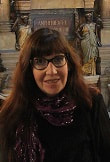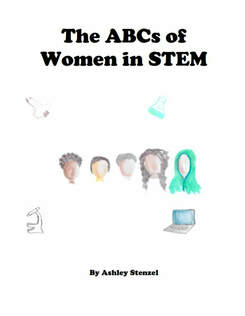|
1/28/2019 0 Comments The ABCs of Women in STEM
By Robbin Koenig
Written and illustrated by Ashley Stenzel, The ABCs of Women in Stem introduces young children to successful women working in various STEM fields. The book could be used as a read aloud with an adult or read independently by 7-9 year-old children. In alphabetical order starting with aerospace engineer and concluding with zoology, each page describes a STEM specialty and the prominent women associated with that discipline. The pages are illustrated with abstract portraiture in the style of Gideon Rubin. Common Core Standards specify that young children need to include nonfiction and informational texts in their literary repertoire. Stenzel’s book could fulfill this mandate in language arts and be a useful addition to the home or school library. Parents may use the book as their daughter’s inauguration into an explorative journey of STEM domains for personal interest and inspiration. The following is a Q and A with author/illustrator, Ashley Stenzel: RK: What inspired you to write this book? How did you transition from active researcher in the adult world to becoming a children’s book author? AS: I was inspired to write this book as a mom-scientist with two young daughters. I began noticing some gender discrimination in the STEM areas when I was in high school and had a male math teacher make comments to me about how a "girl like me" does not belong in STEM. This stuck with me for many years, and I didn't know how to go forward into an area I felt so curious about when such a strong academic figure had told me I cannot. Because of this and other experiences, I wanted to create this book for my daughters to see how many women have joined several different roles in STEM and contribute so much value to these fields. As far as going from research to children's book author, I have been involved in writing and the fine arts for as long as I can remember. I took many art classes and creative writing courses throughout high school, as well as into college. This is something I have always done as a sort of relaxing activity. This happens to be the first time I chose to make one of my creations pu`blicly available, but it was not the first time I wrote a children's book. I have gone back and forth with the idea of submitting my work for publication over the past few years, and by the request of others, this is the first I chose. RK: What made you decide to use an alphabet format? AS: I chose the alphabetical format for a few reasons. One, because one of my daughters is still in preschool I thought this would make it more appealing to her. While my older school-aged daughter loves the book for its content, the concept of the different areas of STEM are a little advanced for preschool. However, the letters make it fun for her to listen to me read it, even if some of the material might go over her head. The other reason I chose alphabetical is I really wanted to touch on many different occupational areas of STEM, but was having a difficult time thinking about how to organize the information. Putting it in an ABC format meant that I could jump around between all the different roles in what I consider to be a fun manner. RK: How did you decide which STEM specialties/fields to include in your book? AS: This is actually an interesting question, because I really struggled with what to include. There are so many intriguing areas of STEM, but something that really limited me is that, unfortunately, I had a hard time finding women in these fields through my searches. Because of this, I spent a lot of time perusing many college websites, looking at all of the different educational STEM programs. Then, after finding one of interest, I searched the internet for women working in these related fields. RK: What was the selection criteria for picking the women to be the subjects? AS: This is something that you will see change from the first to the second edition of this book (yes, there is a second version currently undergoing edits!). In the first version I really eased into it by choosing (for the most part), one occupation per letter and perhaps 1-3 women per occupation. I looked for women who had more personal information readily available so that I could try to get a feel for who they are as a person. This meant having to look past just employer websites or reading material and into people's social media and other publicly available pages. In the first book, you may recognize more well-known females in STEM. In the second edition, I really wanted to change that. I felt that perhaps this was not doing justice to the many fantastic women in STEM who are simply not recognized for the amazing work they do. Because of this, while the first edition will introduce children to a good variety [of female scientists], the second edition will include many more women who are involved in these fields and are currently working in them today. This took a lot more time to really dig into websites like Twitter, professional associations that have member listings, and more. I think this was worth the time because it acknowledges these women who really deserve it, even if they haven't been nominated for a well-known award or have had a lot of noise in the media. RK: Tell me about the illustrations. What media did you use? Why did you decide to use an abstract style and omit the facial features? AS: I went back and forth (and still am for the second edition) with illustrations. I will say I am typically not an abstract painter. It simply isn't in my nature. I think it is a really difficult area to be pleased with your art because it is so subjective. I typically paint or draw detailed portraits. However, I decided to give it a try to make it more “fun” and playful. When I sent the original prints out to some individuals, I wanted to know if they felt I should keep it abstract or use detailed illustrations. One person gave me feedback that really spoke to me. She said "with the faceless abstract illustrations I felt like I could picture myself as that woman in STEM". I thought this was such a cool idea. It wasn't actually what I intended. I thought abstract would simply look more upbeat and playful, but I love the idea of girls looking at these illustrations and seeing themselves. While I really love the idea of omitting the facial features for girls to use their imagination and imagine themselves in that role, I am still struggling with the idea of wanting to do more detailed illustrations for the next edition. This is because I feel like it may be better to acknowledge these women and give them more recognition. It's a difficult decision to make and I have yet to decide. RK: Of all the featured women, which one has the most personal significance to you? AS: All of these women are so amazing and this is a really hard question to answer. Kirsten Moysich is actually my research mentor. I chose to include her since she is both a fabulous scientist, as well as a really wonderful human being. She cares so much about human rights and is a voice at our institution for building up women in science. I thought it was important to add her because of this. Sylvia Earle is also a big name in our household. My oldest daughter adores oceanography and has been reading books and watching films involving Sylvia Earle for some time now. This is how I got the idea for this book. Dr. Earle is such a sweet person. I wrote to her to tell her how much my daughter admires her and asked her to sign a book I had gotten Audrey for Christmas. She sent it back signed with the sweetest note for her. Then I thought, "I can't do something special like this for one child and not the other!" I decided that for my younger daughter (and both really) I would sit down and make this book as a special gift to them from me. RK: Will there be an ABCs of Women in STEM Volume II? AS: There absolutely will be! I have completed writing it, but I am still really debating how I want to go about the illustrations and design. When I wrote the first edition of this book I had no intention of making it publicly available. In fact, I self-published this book so that I could simply buy it for myself to gift to my daughters. After this, people started asking me about buying a copy for themselves, which is how I ended up making it available through Amazon. Almost all of the cost goes to printing, listing, and shipping as a prime eligible book. The royalties I have made in the first edition I have put entirely towards making the second edition. It is something I decided I would really like to do. Had I known people would be interested, I would have liked to include so many fabulous women originally. Now I am correcting this injustice by expanding the second edition. My goal was to include at least 100 women in STEM, increase the number of engineering and technology positions included, and focus on women of today. I am so happy that I was able to achieve this, and without saying too much, I think the second edition is so much better than the first. My goal for this book is really just to help girls AND boys look at all of these women doing such awesome things in STEM and see their purpose in these fields moving forward in an effort to reduce gender discrimination. 
About the Author
Robbin Koenig, M.A., M.S. is an educator with an avid interest in technology and science education. She has taught students in prekindergarten through high school. Robbin enjoys volunteer work, exploring the N.Y.C. cultural arts scene, and anything pertaining to wildlife. Comments? Leave them below!
0 Comments
Your comment will be posted after it is approved.
Leave a Reply. |
LIFESTYLE BLOGRead our lifestyle advice, written exclusively for pre-professional women in science and engineering. From advice about fashion, work and family balance, self, wellness, and money, we've got you covered! |
The Scientista Foundation, Inc. All Rights Reserved © 2011-2021 | Based in NY | [email protected]
The Network for Pre-Professional Women in Science and Engineering
The Scientista Foundation is a registered 501(c)(3) -- Donate!
The Network for Pre-Professional Women in Science and Engineering
The Scientista Foundation is a registered 501(c)(3) -- Donate!

